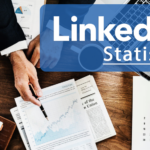If you’re using LinkedIn to promote your brand, you’ve probably come across the term “impressions.”
But what are impressions on LinkedIn, and why should you care about them?
In simple terms, impressions refer to the number of times your content is displayed on someone’s LinkedIn feed.
This metric shows how many people have viewed your content, but it’s not the same as clicks or engagement.
Impressions are an essential metric to track if you want to measure the effectiveness of your LinkedIn marketing strategy.
They represent the potential reach or exposure of your content, and the more impressions you get, the more likely it is that people will engage with your content.
Understanding the difference between organic and paid impressions is also crucial because it can help you optimize your ad spend and create more effective content.
In the next section, we’ll dive deeper into what impressions are and how to calculate them on LinkedIn.
Post Contents
What are Impressions on LinkedIn?

If you’re using LinkedIn for business or marketing purposes, you may have come across the term “impressions.”
Impressions refer to the number of times your content appears on a user’s screen, whether or not they interact with it.
In this section, we’ll discuss what impressions are, as well as the difference between unique impressions and regular impressions.
What are Impressions?
Impressions on LinkedIn are a measure of the reach of your content.
They indicate how many times your content has been displayed on a user’s screen.
This can include your posts, articles, and even your profile.
Impressions are important because they can help you understand how many people are seeing your content and how often.
It’s important to note that impressions are not the same as clicks or engagements.
A user may see your content without actually interacting with it, which will still count as an impression.
Unique Impressions Vs Regular Impressions
When it comes to LinkedIn impressions, there are two types: unique impressions and regular impressions.
Unique impressions are the number of times your content has been seen by unique users.
This means that if a user sees your content multiple times, it will only count as one unique impression.
Regular impressions, on the other hand, count every time your content is displayed, regardless of whether it’s the same user or not.
Understanding the difference between unique impressions and regular impressions can help you better understand your content’s reach.
For example, if you have a high number of regular impressions but a low number of unique impressions, it may indicate that your content is being seen by the same users repeatedly.
Importance of Impressions on LinkedIn
As you use LinkedIn to grow your business or advance your career, it’s important to understand the significance of impressions.
Impressions are the number of times your content is shown to individual LinkedIn members.
Here are some reasons why impressions matter:
Measuring Success
Impressions are a great way to measure the success of your content on LinkedIn.
By tracking impressions, you can see how many people are seeing your content and how often.
This can help you determine which types of content are most effective at reaching your target audience.
Impact on Reach
Impressions have a direct impact on your reach on LinkedIn.
The more impressions your content receives, the more people it will reach.
This can help you expand your network and increase your visibility on the platform.
Engagement Rate
While impressions are important, it’s also important to consider engagement rate.
Engagement rate measures the number of likes, comments, and shares your content receives.
This metric can help you determine how engaged your audience is with your content and whether your content is resonating with them.
To summarize, impressions are a valuable metric for measuring the success of your content on LinkedIn.
By tracking impressions, you can see how many people are seeing your content, how often, and how engaged they are with it.
This can help you create more effective content and expand your reach on the platform.
Types of LinkedIn Impressions

When it comes to LinkedIn impressions, there are two main types: organic impressions and paid impressions.
Here’s what you need to know about each:
Organic Impressions
Organic impressions refer to the number of times your content, such as a post or article, was seen by someone without any paid promotion.
This means that the content was seen by someone through their own LinkedIn feed, or through a search result.
Organic impressions are important because they can help you gauge the reach and engagement of your content.
If you’re consistently getting high organic impressions on your posts, it’s a good sign that your content is resonating with your audience.
Paid Impressions
Paid impressions, on the other hand, refer to the number of times your content was seen as a result of paid promotion.
This means that you paid to have your content shown to a specific audience, rather than relying on organic reach.
Paid impressions are important because they allow you to target specific audiences and get your content in front of people who may not have seen it otherwise.
However, it’s important to note that paid impressions can be more expensive than organic impressions, and may not always result in the same level of engagement.
When it comes to LinkedIn impressions, it’s important to track both organic and paid impressions to get a full picture of your content’s performance.
By doing so, you can make informed decisions about how to best reach and engage your audience on the platform.
How to Increase Impressions on LinkedIn
If you’re looking to increase your impressions on LinkedIn, there are a few strategies you can use to improve your visibility on the platform.
Here are some tips to help you get started:
Optimizing Your Profile
Your LinkedIn profile is often the first thing people see when they come across your account.
To make sure your profile is optimized for maximum visibility, make sure you:
- Use a professional profile picture
- Write a compelling headline that showcases your expertise
- Customize your LinkedIn URL
- Write a summary that highlights your skills and experience
- Add relevant work experience and education
- Use keywords in your profile to help people find you in search results
By optimizing your profile, you can increase the chances that people will find you when they’re searching for professionals in your industry.
Creating Engaging Content
One of the best ways to increase your impressions on LinkedIn is to create engaging content that resonates with your audience.
Here are some tips to help you create content that people will want to engage with:
- Use eye-catching visuals in your posts
- Write attention-grabbing headlines
- Make your content easy to read and understand
- Share your own insights and experiences
- Ask questions to encourage engagement
- Respond to comments and messages promptly
By creating engaging content, you can increase the chances that people will like, comment on, and share your posts, which can help increase your impressions on LinkedIn.
Using LinkedIn Ads
If you’re looking to increase your impressions on LinkedIn quickly, you may want to consider using LinkedIn ads.
LinkedIn offers a variety of ad formats that can help you reach your target audience and increase your visibility on the platform.
Here are some tips to help you get started with LinkedIn ads:
- Set clear goals for your ad campaign
- Choose the right ad format for your goals
- Target your ads to the right audience
- Use compelling visuals and copy in your ads
- Monitor your ad performance and adjust your strategy as needed
By using LinkedIn ads, you can increase your impressions on the platform and reach a wider audience of professionals in your industry.
By following these tips, you can increase your impressions on LinkedIn and improve your visibility on the platform.
Analyzing Impressions with LinkedIn Analytics

If you’re looking to track your LinkedIn marketing performance, impressions are a key metric to monitor.
In this section, we’ll explore how you can use LinkedIn Analytics to analyze your impressions and track your progress over time.
Understanding the Metrics
First, let’s define what impressions are on LinkedIn.
Impressions refer to the number of times your content has been displayed on someone’s LinkedIn feed or page.
This metric is important because it can help you understand how many people are potentially seeing your content.
Within LinkedIn Analytics, you can view impressions by post, page, or campaign.
You can also filter by date range, content type, and more.
By analyzing your impressions over time, you can identify trends in your content performance and adjust your strategy accordingly.
Tracking Progress
To track your progress with impressions, start by setting goals for your content.
For example, you might aim to increase your impressions by a certain percentage each month.
Then, use LinkedIn Analytics to monitor your progress toward these goals.
One way to do this is to create a dashboard in LinkedIn Analytics that displays your impressions by content type, date range, and other relevant filters.
You can also use this dashboard to compare your performance to industry benchmarks and identify areas for improvement.
In addition to tracking your impressions, it’s important to also analyze other metrics like engagement, click-through rates, and conversions.
By looking at these metrics in conjunction with your impressions, you can get a more complete picture of your content performance on LinkedIn.
Impressions and Other LinkedIn Metrics
When it comes to measuring the success of your LinkedIn posts, there are several metrics to consider.
Impressions are one of the most important metrics to track.
Impressions refer to the number of times your post has been viewed by LinkedIn users.
However, it’s important to understand how impressions compare to other metrics to get a better understanding of your post’s performance.
Impressions Vs Views
Impressions and views are often used interchangeably, but they are not the same thing.
Views refer to the number of times your post has been clicked on and viewed by a user.
Impressions, on the other hand, refer to the number of times your post has been displayed to a user, regardless of whether or not they clicked on it.
Impressions Vs Clicks
Clicks refer to the number of times a user has clicked on your post.
Impressions, as we mentioned earlier, refer to the number of times your post has been displayed to a user.
By comparing the number of clicks to the number of impressions, you can determine the click-through rate (CTR) of your post.
A high CTR indicates that your post is engaging and relevant to your audience.
Impressions Vs Engagement
Engagement is a metric that refers to any interaction with your post, such as likes, comments, and shares.
Impressions are important because they give you an idea of how many people have seen your post, but engagement is a better indicator of how well your post is resonating with your audience.
By comparing the number of impressions to the number of engagements, you can determine the engagement rate of your post.
A high engagement rate indicates that your post is resonating with your audience and encouraging them to take action.
Key Takeaways
When it comes to LinkedIn impressions, there are a few key takeaways you should keep in mind to increase your success on the platform.
First, it’s important to understand what impressions are.
Impressions refer to the number of times your content is shown to individual LinkedIn members.
Unique impressions are the number of times your content is shown to unique individuals.
It’s important to track your impressions to understand how your content is performing and to identify areas for improvement.
Next, it’s important to focus on organic impressions rather than paid impressions.
While paid impressions can be useful for reaching a larger audience, organic impressions are a better indicator of how engaging and relevant your content is to your target audience.
To increase your LinkedIn impressions, focus on creating high-quality, engaging content that is tailored to your target audience.
Use relevant keywords and hashtags to make your content more discoverable, and engage with your audience by responding to comments and messages.
Finally, don’t be afraid to experiment with different types of content, such as videos, infographics, and long-form articles.
By diversifying your content, you can reach a wider audience and increase your chances of success on LinkedIn.






























